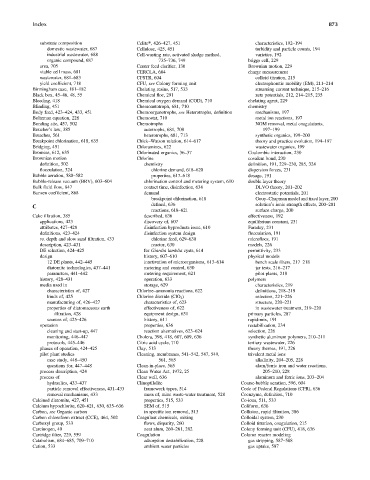Page 918 - Fundamentals of Water Treatment Unit Processes : Physical, Chemical, and Biological
P. 918
Index 873
substrate composition Celitet, 426–427, 451 characteristics, 192–194
domestic wastewater, 687 Cellulose, 425, 451 turbidity and particle counts, 194
industrial wastewater, 688 Cell-wasting rate, activated sludge method, varieties, 192
organic compound, 687 735–736, 749 briggs cell, 229
urea, 705 Center feed clarifier, 130 Brownian motion, 229
viable cell mass, 681 CERCLA, 604 charge measurement
wastewater, 681–683 CFSTR, 604 colloid titration, 215
yield coefficient, 718 CFU, see Colony forming unit electrophoretic mobility (EM), 211–214
Birmingham case, 181–182 Chelating resins, 517, 533 streaming current technique, 215–216
Black box, 45–46, 48, 55 Chemical floc, 291 zeta potentials, 212, 214–215, 235
Bleeding, 418 Chemical oxygen demand (COD), 710 chelating agent, 229
Blinding, 451 Chemoautotroph, 681, 710 chemistry
Body feed, 423–424, 433, 451 Chemoorganotrophs, see Heterotrophs, definition mechanisms, 197
Boltzman equation, 228 Chemostat, 710 metal ion reactions, 197
Bonding site, 457, 502 Chemotrophs NOM removal, metal coagulatants,
Boucher’s law, 385 autotrophs, 681, 708 197–199
Breaches, 561 heterotrophs, 681, 713 synthetic organics, 199–200
Breakpoint chlorination, 618, 635 Chick–Watson relation, 614–617 theory and practice evolution, 194–197
Bridging, 451 Chloramines, 622 wastewater organics, 199
Bromine, 612, 635 Chlorinated organics, 36–37 Coulombic interaction, 230
Brownian motion Chlorine covalent bond, 230
definition, 502 chemistry definition, 191, 229–230, 285, 324
flocculation, 324 chlorine demand, 618–620 dispersion forces, 231
Bubble aeration, 580–582 properties, 617–618 dosage, 191
Bubble-release vacuum (BRV), 603–604 chlorination control and metering system, 610 double layer theory
Bulk fluid flow, 847 contact time, disinfection, 634 DLVO theory, 201–202
Bunsen coefficient, 868 demand electrostatic potentials, 201
breakpoint chlorination, 618 Gouy–Chapman model and fixed layer, 200
C defined, 636 solution’s ionic strength effects, 200–201
reactions, 618–621 surface charge, 200
Cake filtration, 385 described, 636 effectiveness, 192
applications, 423 discovery of, 607 equilibrium constant, 231
attributes, 427–428 disinfection byproducts issue, 610 Faraday, 231
definitions, 423–424 disinfection system design flocculation, 191
vs. depth and slow sand filtration, 433 chlorine feed, 629–630 microflocs, 191
description, 423–431 reactor, 630 models, 226
DE selection, 424–425 for Giardia lamblia cysts, 614 permittivity, 233
design history, 607–610 physical models
12 DE plants, 442–445 inactivation of microorganisms, 613–614 bench scale filters, 217–218
diatomite technologies, 437–441 metering and control, 630 jar tests, 216–217
parameters, 441–442 metering requirement, 621 pilot plants, 218
history, 428–431 operation, 633 polymers
media used in storage, 629 characteristics, 219
characteristics of, 427 Chlorine–ammonia reactions, 622 definitions, 218–219
kinds of, 425 Chlorine dioxide (ClO 2 ) selection, 221–226
manufacturing of, 426–427 characteristics of, 623 structure, 220–221
properties of diatomaceous earth effectiveness of, 622 in wastewater treatment, 219–220
filtration, 428 equipment design, 631 primary particles, 287
sources of, 425–426 history, 611 rapid-mix, 191
operation properties, 636 restabilization, 234
cleaning and start-up, 447 reaction alternatives, 623–624 selection, 226
monitoring, 446–447 Cholera, 398, 418, 607, 609, 636 synthetic aluminum polymers, 210–211
protocols, 445–446 Citric acid cycle, 710 tertiary wastewater, 226
phases of operation, 424–425 Clay, 513 theory themes, 191, 226
pilot plant studies Cleaning, membranes, 541–542, 547, 549, trivalent metal ions
case study, 448–450 561, 565 alkalinity, 204–205, 228
questions for, 447–448 Clean-in-place, 565 alum=ferric iron and water reactions,
process description, 424 Clean Water Act, 1972, 25 205–210, 228
process of Clear well, 636 aluminum and ferric ions, 203–204
hydraulics, 433–437 Clinoptilolite Coarse-bubble aeration, 596, 604
particle removal effectiveness, 431–433 framework types, 514 Code of Federal Regulations (CFR), 636
removal mechanisms, 433 mass of, mine waste-water treatment, 528 Coenzyme, definition, 710
Calcined diatomite, 427, 451 properties, 515, 533 Co-ions, 511, 533
Calcium hypochlorite, 620–621, 630, 635–636 SEM of, 515 Coliform, 636
Carbon, see Organic carbon in specific ion removal, 513 Collision, rapid filtration, 386
Carbon chloroform extract (CCE), 464, 502 Coagulant chemicals, mixing Colloidal system, 230
Carboxyl group, 533 flows, disparity, 260 Colloid titration, coagulation, 215
Carcinogen, 40 neat alum, 260–261, 282 Colony forming unit (CFU), 418, 636
Cartridge filter, 229, 559 Coagulation Column reactor modeling
Catabolism, 684–685, 709–710 adsorption destabilization, 228 gas stripping, 587–588
Cation, 533 ambient water particles gas uptake, 587

